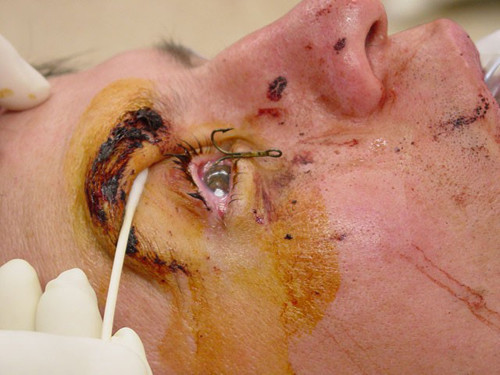WARNING, GRAPHIC IMAGE BELOW
Unexpectedly, in many quarters this has not been as good a season as many hoped for or expected. We had plenty of rain in early June which brought a good run of fish on many of the sewin rivers but this was not followed by the expected runs in July and into August. Persistent anglers are still catching the odd fish mainly in the 2-4lb range but very few bigger fish have been grassed. There are mixed reports on small sewin i.e. those first returners, some have been lucky to be in the right place at the right time whilst others have bemoaned the lack of these fish. It is difficult, at best, to understand why some age groups seem to be very scarce some years whilst in others they seem plentiful. It is wise not to try to extrapolate the lack of year groups in sewin runs as next year could and hopefully will be a good year for all age classes!
Although we have certainly had good nights to fish this year, they have been in short supply during the last month. Windy nights have been prevalent but even during the better nights the fish have been in the main unwilling to “play ball”! This is true even in pools which have been populated by a decent number of fish. The day fishing after recent rains has also been poor although a few anglers have been well rewarded for their efforts.
September is a month traditionally of a weather change. Wind and rain is often the case and therefore the sewin fisherman has to be ready to go fishing either in the day or the night whilst some of the anglers traditionally fished mainly for salmon in higher water in September. Unfortunately, the salmon fishing in many of our rivers which expected an Autumn run has diminished greatly in recent years.
For those who want to fish at night in September the floating lure, either a Jambo or a Gurgler or any other large floating fly which causes a wake is probably as good as anything to tempt a sewin. As discussed before, this fly should be cast slightly (about 10°) upstream allowed to settle and then in short strips retrieved. One will often hear a noise such a “blwp” when a fish gets interested in the lure – hold your nerve until you feel the weight of the fish. As I have indicated before, I personally like to fish these lures on a 15’ intermediate or hover tip, it seems that I do get more positive takes and less splashing at the lure. I normally use tapered leaders for this type of fishing, but if you do, keep them stout with a breaking strain of at least 12lb which will allow you to land pretty well any size of sewin which you might encounter. Regardless of how you fish the lure, do not tighten until you feel the weight of the fish. Although most commercially tied lures will have both a single and a trailing treble hook it is wise for those who buy flies to cut off the treble for late season fishing as it is unlikely that the fish would be suitable for eating having been in the river for many weeks if not months. For those who tie their own flies and want a trailing hook it might be worthwhile adding a single hook at the back.
For those who maybe have no floating lures in their flybox, they can create an alternative, with better results at times by fishing with two plastic tubes fished on a floating line. The two flies should be tied about 4’ apart on the tippet with the larger of the two (1.5” is probably best) on the point with one of 1.25” on the dropper. The cast should be made pretty square and as the flies are retrieved slowly the rod tip should be raised. The dropper fly will not skate but will probably produce a subsurface wake which will excite the fish. If the fish takes he will more often than not be well hooked and on the point fly. This is probably because he has followed the wake, turned and then taken the point fly whilst swimming away from the angler. It really works well at times and one can, using a hot needle to create the hole just behind the eye of the dropper create even more of a wake which is useful on when there are ripples on the water surface.
The small sewin can also be fun if you target them. Small trout flies fished fast close to the surface will often do the trick especially when the water is in good flow, higher than summer low but certainly not in flood. Three fly leaders of about 10’ of 6 or 8lb nylon or fluorocarbon will work well. The cast should be made quite square and the flies should be retrieved quite quickly either with a fast figure of eight or in short strips. I normally use a 5 or 6wt rod for this fishing as the smaller fish will give a good account of themselves on this tackle. The runs of fresh smaller sewin are still with us which allows one to catch some really silver fish straight from the sea. They are also ready takers which makes for great enjoyment.
Lastly I would implore you to use eye protection for all your fishing and especially clear glasses if you are night fishing. I recently came across three anglers in the small hours, none of which was wearing eye protection! This sadly is a graphic image of a fisherman who was not wearing eye protection. I do not apologise for showing this if it deters any angler from not fishing without spectacles!
Illtyd Griffiths
AAPGAI Master Fishing Instructor and Senior Assessor for trout, sea trout and salmon.
